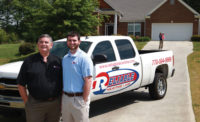Defining Variable Speed for Customers

The Danfoss Performer VSD scroll compressor combines R-410A with variable- frequency drive for high performance.
There is often a communications gap when it comes time for an HVAC technician to explain to a customer how HVAC equipment operates. The conversation may become too technical and the customer is often left with a “deer in the headlights” expression on their face. Sadly, this communication disconnect often has a negative impact on customer service.
One of the most common HVAC technologies - common to people inside the trade - is variable speed. Although most HVAC people know its definition and how it affects equipment performance, chances are that most customers have limited or no understanding of how it affects the equipment in their basement or attic. The fact that variable speed affects efficiency and therefore impacts utility costs should be enough to grab the interest of customers. But sadly, it isn’t an exciting or interesting topic to most non-HVAC types.
So how does the trade make it more interesting and help customers understand its importance? The best way would be to make technology more understandable - maybe even more interesting.
Dan Schillinger, business development, variable speed for Danfoss offered a definition and more important, an analogy. “Variable-speed drives (VSDs) allow systems to be more efficient by precisely matching operation to demand, which can vary throughout the day based on a building or home’s cooling needs,” he said. “Typical HVAC systems today only operate in either full-on or -off modes, but the addition of variable speed drives allows the system to operate under part load conditions.
“A good analogy is this: Imagine driving your car with only a toggle switch to determine your speed. In this situation, you have two options - full speed or off. VSDs act similarly to an accelerator pedal, which enables the driver to control and match the speed of the car to their exact needs.”
Bill Genaw, product manager for HVAC drives at Eaton, also used the acceleration/deceleration approach to explain variable speed. “A variable-speed drive is a solid state controller that is used to control motor speed,” he said. “VSDs are able to match motor speed to output requirements - so that you use the energy you need. This could be acceleration or deceleration time, or handling speed control anywhere in-between. By controlling motor acceleration and running at slower speeds, users can achieve significant energy savings over time. Additionally, variable-speed drives are able to help extend equipment life by gradually accelerating the motor.”
ZEROING IN ON HVAC
Now, if customers had a clearer understanding of what VSDs are, they might be ready to see how this technology applies to the equipment they own. It might even be the right time to break out some technical terminology if technicians have gained their attention. At this point, a short history lesson may be in order.“Over the years, variable-speed technology has become less complex with simpler menus and user interface,” said Schillinger. “The physical size of variable- speed drives has decreased, which means that OEMs are also able to shrink the footprint of their equipment while increasing a system’s energy efficiency.”
Genaw also added that smaller sizes have evolved over the years. “Today, drives are smaller, more efficient, accurate, and offer customers increased functionality,” he said. “They are now used to provide a lower total cost of ownership to the end user - both in terms of reduced energy consumption and extended equipment life. New and sophisticated technologies are improving efficiency, and yielding more finely tuned variable-speed drives.”
It’s all about efficiency, according to Schillinger. “Variable-speed technology has become a widely accepted method of achieving higher efficiency levels,” he said. “Additionally, improved power factor correction methods mean that the addition of a variable speed drive is considered an upgrade when compared to standard motors.”

The Eaton Corporation features its M-Max Series of sensorless vector adjustable-frequency drives.
That’s all good for the present, but are there future trends that customers might like to be aware of? If technicians still have their customer’s attention, it might be a good time to mention VSD, especially since VSDs are becoming more mainstream, according to Schillinger. “We can expect variable speed technology to spread from specialty, high efficiency applications to more general use,” he said. “VSDs will become an integral component for equipment designed to operate on a smart grid, which we predict will be the future of power grid optimization.
“Specifically, because of power factor correction, which minimizes the amount of noise fed into the power supply by the VSD, we will be able to reduce the load on transformers and power grid losses. The benefits of variable speed will only multiply when incorporated into systems designed to control and reduce energy use.”
Schillinger noted that proposed regional efficiency standards will drive a regional focus on SEER ratings, which will encourage system OEMs to further evaluate variable speed as a means of drawing greater efficiencies from heating and cooling equipment.
Genaw used the “A” word - algorithms - to describe future trends. “There have been great strides in application control algorithms to maximize energy efficiency,” he said. “Advanced algorithms deliver significant energy savings in variable torque applications. By reducing losses within the motor, the algorithms are designed to make the motor more efficient as well as the entire system - motor, drive and load - more efficient. They can improve energy savings and stability. By dynamically adjusting the operating point of the motor-drive system in response to load conditions, algorithms can reduce motor losses and save energy.”
Both Genaw and Schillinger understand that getting this information to technicians in a way that is understandable to customers is very important. That’s why they said that training is key. “The best way anyone can learn about and interact with variable-speed technology is through training,” Schillinger said. “At Danfoss, we offer multiple training courses on VSD performance, benefits, installation and maintenance.”
Genaw added, “Leading manufacturers offer robust training programs to help customers implement the right solution for their unique needs.”
With a little basic understanding of variable-speed technology and VSDs, the communications gap between technicians and customers can be greatly reduced - a big plus when it comes to customer service.
For more information on variable-speed technology, visit www.eaton.com or www.danfoss.us.
Publication date: 04/04/2011







